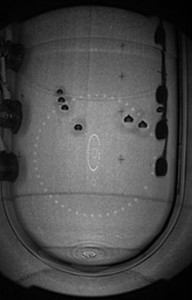
Photo: Courtesy of COUPP. The COUPP Collaboration uses bubble chambers to look for dark matter. This photo shows a seven-bubble event induced by a neutron calibration source in the COUPP-60 detector, now running underground at
SNOLAB
in Ontario, Canada.
The headline story in the April 15 issue of Fermilab Today featured the observation by the CDMS experiment of three candidate events that could have been produced by dark matter. That result, combined with several other possible signals, points to a dark matter candidate that is much lighter than expected. While no one is claiming that dark matter has definitely been discovered, there is certainly a lot of interest in this low-mass region of space.
The COUPP collaboration builds bubble chambers to look for dark matter. A bubble chamber consists of a superheated fluid, or a fluid that is heated past its boiling point (like this
mug of water), and when a particle interacts in the liquid, enough heat can be deposited to form a bubble. The key for COUPP bubble chambers is that, to form a bubble, the particle must deposit its energy over a relatively small distance. One of the biggest backgrounds to dark matter searches comes from gamma rays. Because gamma rays deposit their energy over a distance that is large compared to the bubble, they don’t produce events in the COUPP bubble chamber. Therefore, COUPP never even sees the largest background to dark matter searches. That’s a good thing when you’re looking for tiny signals that would otherwise be awash in unwanted backgrounds.
What does this have to do with the CDMS result and light dark matter? Well, historically, COUPP has used a chemical called CF3I as the target in its bubble chambers (including the new COUPP-60 experiment, which is just beginning its physics run this week). However, CF3I is not ideally suited to looking for light dark matter because it’s too heavy.
Containing just carbon and fluorine, C3F8 is an ideal target to look for light dark matter. Recently, COUPP used C3F8 inside a bubble chamber to see whether it has the same level of rejection against the gamma rays, and the preliminary data show that a C3F8 target does just fine. The plot below shows that gamma rejection: At a 3-keV threshold, the probability of a gamma ray making a bubble is less than 1 in 100 million. At that threshold, if the CDMS signal were real, a 2-liter C3F8 chamber would expect to see almost 1 event per day coming from dark matter. With this result in hand, COUPP is now trying to deploy a small chamber with C3F8 to start hunting dark matter this summer. If all goes well, the mystery of light dark matter may be solved a year from now.

At a 3-keV threshold, the probability of a gamma ray making a bubble is less than 1 in 100 million. At that threshold, if the CDMS signal were real, a 2-liter C3F8 chamber would expect to see almost 1 event per day coming from dark matter.
– Hugh Lippincott









